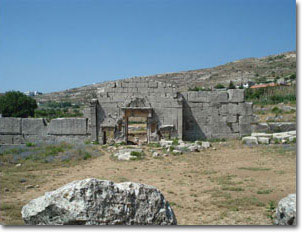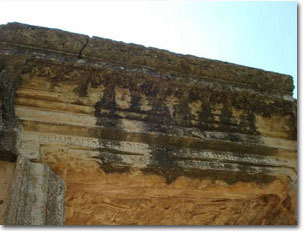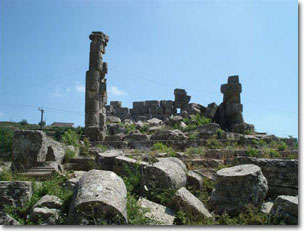|
 About
30 km east of Tartous; Husn Suleiman (Suleiman's Castle) is one of the
most extraordinary set of ruins in Syria. The remains are exceptional
for the juxtaposition of the gigantic and the aesthetic: the cyclopean
scale of the component blocks set against the tranquility and beauty of
the setting in one of the remote stretches of the Jebel Ansariye. About
30 km east of Tartous; Husn Suleiman (Suleiman's Castle) is one of the
most extraordinary set of ruins in Syria. The remains are exceptional
for the juxtaposition of the gigantic and the aesthetic: the cyclopean
scale of the component blocks set against the tranquility and beauty of
the setting in one of the remote stretches of the Jebel Ansariye.
The present remains are Roman. The Roman construction probably began in
the first century AD but the greater part of the effort to
monumentalize the cult center took place at the end of the second
century, under Severan rules. A cult center has existed here for millennia. The first temple was
probably constructed under Persian domination when the area known now
as the Meshta was settled. The present remains are Roman but occupy the
site of a Semitic/Canaanite cult to the local version of Baal whose
worship was later merged with the Greek equivalent, Zeus, under the
title Zeus Baotocecian. Astarte was associated with the center, maybe
because of the spring flowing through the site. 
The Roman construction probably began in the 1st century AD but the
greater part of the effort to monumentalize the cult center took place
at the end of the 2nd century , under Severan rule. The enclosure consists of a large compound open to the sky with a small
central cella to house the altar. The same plan is employed in the Bel
Temple of Palmyra. There are four gates centrally placed in each face
of the outer wall. The propylaeum (Latin name for what comes before any
gateway; the name is based on the original Propylaea that serves as the
entrance to the Acropolis) in front of the north gateway is the most
elaborate with porticos of eight columns on each side of the triple
entrance doorway. The outer portico was adorned with two niches, two
side entrances and a Syrian styled relieving arch over the elaborate
lintel. On the eastern doorway, there's a Greek inscription dated 171 which
records the dedication of the complex by the local people. At the four
gates, the figures of eagles were adorned, remains of which are still
seen in different stages of preservation.  
 
|


